This site uses cookies as defined in our Cookie Policy, by continuing to use this site you agree to their use.
Continue
Fares shown include 1 pre-hotel night in London Tower Bridge – total trip duration 13 nights starting 04/05/2023
Discover some of the United Kingdom’s most historically significant and wildlife-rich destinations on this voyage from Portsmouth to Aberdeen. With numerous islands located in the Atlantic Ocean, a vast amount of the UK coastline is ideal for exploration by ship. In England, Wales and Scotland, there are designated Heritage Coasts, some which fall within national parks and Areas of Outstanding Natural Beauty, and some standalone coastal str... ips that are protected simply because they are part of a particular location’s heritage. Stroll through charming fishing villages, visit majestic castles, cathedrals, historical homes and gardens, encounter magnificent archaeological sites, witness a dazzling array of birds, and soak up the remarkable history of a land that has been continuously inhabited for over 5,000 years.
| Arrive | Depart | ||||||
| 4th04 | MayMay | 202323 | 1 night accommodation before your cruise, staying in London Tower Bridge | ||||
| 5th05 | MayMay | 202323 | Portsmouth, England, embark on the Greg Mortimer | ||||
| Portsmouth is one of the most densely populated cities in Southern England, and is unusual as most of its built-up area occupies Portsea Island, linked to the mainland by road and rail bridges. Although there is a Roman fort at nearby Portchester, occupied later by the Saxons and Normans, there was no settlement on the site of Portsmouth at the time of the 1086 Domesday Book. The town developed in medieval times and received its first charter in 1194 from King Richard I; soon afterwards it became a major naval base. It has the world’s oldest dry dock, and is home to several famous ships, including HMS Victory, HMS Warrior and the Mary Rose, raised from the Solent in 1982. Portsmouth remains an important naval base and is home to a large proportion of the British service fleet. The waterfront area is now dominated by the Spinnaker Tower, 560 feet high, the United Kingdom’s tallest building outside London. Other things to see in the city include the house where Charles Dickens was born, and the City Museum, which contains a permanent exhibition devoted to another famous writer, Sir Arthur Conan Doyle, who lived in the town. This morning, your luggage will be collected from the hotel and transferred directly to the port for sanitisation, clearance and delivered to your cabin ahead of your arrival on board. Please ensure that your luggage is fitted with cabin tags clearly labelled with your name and cabin number. Any valuables or personal items should be kept with you throughout the day. Final, mandatory pre-embarkation health screening and COVID (rapid antigen) testing will be completed before transferring to the Portsmouth for embarkation. Depart London as you travel to Portsmouth Historic Dockyard. This ancient dockyard is home to two of the most iconic ships in British maritime history: Mary Rose and HMS Victory. The Mary Rose, Henry VIII’s flagship, which capsized while fighting the French in 1545, was recovered from the seabed in 1982. In dry dock alongside the Mary Rose, is HMS Victory. Constructed in the 18th century and famed for her part in the Battle of Trafalgar in 1805, Victory was the flagship of Admiral Lord Nelson, who was infamously fatally shot by a sniper while on deck. On arrival at the Portsmouth Historic Dockyard, your guide will escort you to your lunch venue inside the grounds for a two-course meal. Enjoy some free time after lunch to explore at your leisure. Rejoin your guide as you depart on a panoramic tour of the city. Portsmouth is rightly famed for its naval heritage and harbour but there is so much more to discover. We head out to Portsdown Hill, from where you will have (weather permitting) one of the best views in England, overlooking the whole of Portsmouth. On a clear day, you will be able to see as far as Southampton, Chichester and the Isle of Wight. Learn about the events and people that have shaped Portsmouth across the centuries, including Charles Dickens, who was born in Portsmouth, and Sir Arthur Conan Doyle, who started writing his Sherlock Holmes stories while practising as a doctor in Southsea. Driving through the 19th-century seaside resort of Southsea with its naval memorials, we glimpse Southsea Castle, built by Henry VIII in the 16th century. The panoramic tour continues to Old Portsmouth, including Spice Island, where Portsmouth first started. Here you will discover some of the city’s historical buildings and defences as well as the headquarters of Britain’s America’s Cup team, before arriving at Portsmouth Port and your awaiting ship. Settle into your cabin before attending important safety briefings and enjoy the thrill of departure as we ‘throw the lines’ and set sail. This evening, get to know your fellow expeditioners and our friendly Expedition Team and crew at the Captain’s Welcome Dinner to celebrate the start of a thrilling adventure. | |||||||
| 6th06 | MayMay | 202323 | Fowey, England | ||||
| Nestled in the mouth of a wooded estuary, Fowey (pronounced Foy) is still very much a working china-clay port as well as a focal point for the sailing fraternity. Increasingly, it's also a favored home of the rich and famous. Good and varied dining and lodging options abound; these are most in demand during Regatta Week in mid- to late August and the annual Fowey Festival of Words and Music in mid-May. The Bodinnick and Polruan ferries take cars as well as foot passengers across the river for the coast road on to Looe.A few miles west of Fowey are a pair of very different gardens: the Eden Project, a futuristic display of plants from around the world, and the Lost Gardens of Heligan, a revitalized reminder of the Victorian age. Located on the south coast of Cornwall, Fowey has a strong Celtic connection and is steeped in maritime history. The buildings of Fowey tell the tales of its past. The ancient castles at the deep-water entrance once guarded the harbour from Spanish fleets and, in the heart of the town, the towers of the 14th-century St Fimbarrus Church and the 15th-century Place House still stand proud. Our ship will take centre stage on its mooring right in the heart of Fowey. While you immerse yourself in the Cornish lifestyle, the ship will be the talk of the town. Choose two of the following shore excursion options below to create your experience for the day. Coastal Hike Depart Fowey Harbour by coach for the scenic drive to the fishing village of Gorran Haven. Set off on foot through the narrow medieval streets towards the beach, before continuing uphill to the cliffs from where the hike along the southwest coast path begins. The route takes you through wild meadows and along clifftop paths, offering magnificent panoramas. The coastal path descends towards Turbot Point, where the sheer cliffs are known as Bodrugan’s Leap, after Sir Henry Bodrugan, who made his escape from his pursuing enemy, Sir Richard Edgcumbe of Cotehele, by leaping from the cliff into a boat that took him to safety in France. Taking in Chapel Point en route, continue to Port Mellon, a delightful cove with a long history of boat building. As the route nears closer to the end of the walk, glimpse a first view of Mevagissey and the lovely sweep of Mevagissey Bay. As the lane descends, see splendid views of the picturesque harbour, before arriving for free time to enjoy Mevagissey at leisure. Perhaps explore the village, relax and soak up the scenery, or visit one its many charming cafes for a Cornish cream tea (not included). Lost Gardens of Heligan Depart Fowey this morning for the one-hour journey to the magical Lost Gardens of Heligan. Your route crosses a peaceful countryside of small villages and granite farmhouses, giving you glimpses of life here in days gone by and the hedged fields that give way to rolling downs as you approach Heligan, which is the Cornish name for the willow tree. The Lost Gardens, situated near the fishing village of Mevagissey, are set on 80 hectares (200 acres) and include a complex of walled gardens, greenhouses and a huge vegetable garden. The gardens are claimed as the site of the largest garden restoration in Europe. As if from a fairytale, the 57-acre gardens were lost for 70 years beneath a mass of ivy, brambles and fallen timber. In 1991, they were ‘rediscovered’ and have been beautifully restored to incorporate rockeries, summerhouses and a crystal grotto. Explore the gardens on your own and marvel at this once-forgotten world. Stroll, or stop and perch on a bench, of which there are many dotted throughout the gardens, to enjoy the tranquil environment offered by the plants and birdlife. As well as being named ‘Large Attraction of the Year 2018/19’ at the Cornwall Tourism Awards, the Lost Gardens of Heligan also won the prestigious British Travel Award for Best UK Leisure Attraction in both 2016 and 2017. Fowey by Foot Join your guide for a walking tour of Fowey, a picturesque port town dominated by its links to fishing, shipbuilding, trading and privateering. Stroll along the narrow streets, dating back as far as the 15th century, to Fowey Town Quay, from where you can enjoy fantastic views of Polruan on the opposite shore. See the ‘Rook with a Book’ sculpture created to celebrate the famous writer Daphne du Maurier, who lived in Fowey – the local area being the inspiration and setting for her well-known novels Rebecca, My Cousin Rachel and her short story, The Birds, famously adapted for film by Alfred Hitchcock. Continue to Readymoney Cove onto the southwest coast path, walking through woodland to the ruins of St Catherine’s Castle. Hear tales of pirates, and privateers – individuals commissioned by governments to carry out quasi-military activities. They would sail in privately owned armed ships, robbing merchant vessels and pillaging settlements belonging to a rival country. On returning to Fowey town, enjoy some free time to explore independently before rejoining your guide and returning to Albert Quay. Pit to Port: Wheal Martyn & Charlestown Explore Cornwall’s unique mining history, see vintage trucks and working waterwheels, discover modern machines in action in the working clay pit and visit the pristine working Georgian port of Charlestown. Wheal Martyn tells the story of Cornwall’s largest mining industry – china clay. Found in very few places around the world, the deposits of china clay in Cornwall and Devon are the largest globally. The mining of china clay in Cornwall continues today and was the largest driver of the local economy for 100 years. Cornish china clay has been exported worldwide and is used in a wide array of everyday products, ranging from ceramics to paper and paint, to the more unusual such as spacecraft components. Based around two former Victorian-era china clay works, much of which have been designated a Scheduled Ancient Monument, Wheal Martyn takes you through the story of china clay production from 1800 to the present day. Set off on the historic trail for a tour of the preserved Victorian China Clay works that reveals Wheal Martyn’s past life at the heart of this global industry. Follow in the footsteps of the clay workers and learn about the lives of the men, women and children who lived, worked and played in the shadows of the Cornish ‘white pyramids’ in Cornwall’s dramatic clay country. Explore ancient buildings such as the crib hut and flat rod tunnel, see industry tools, vintage commercial vehicles, and walk around the fascinating settling pools. This unique site includes Cornwall’s largest remaining working waterwheel. You can enjoy some free time following the trail to the top of the site for an impressive view of a modern, working clay pit. From the observation deck, watch giant machinery in action and see how the historical china clay mining methods have evolved over the years. There’s also a gift shop and cafe. Continue the discovery of Cornwall’s rich industrial past with a visit to nearby Charlestown. Originally called Polmear, and consisting of just a few tiny cottages, it was developed in the late 18th century by entrepreneur Charles Rashleigh, who built a harbour and increased the size of the settlement. Charlestown, as it was then known, was designed to meet the growing transport needs of the region’s mining boom. The beautifully preserved Georgian port is the oldest china clay port in the world. China clay was transported from the ‘dries’ in and around St Austell to Charlestown in horse-drawn wagons and exported throughout the world. The approach to the port, known as Great Charlestown Road, was designed to take six horse-drawn carts abreast: three going uphill and three going downhill. The road was, and still is, the widest approach road of any port in Cornwall. Enjoy free time to delve deeper into the history of Charlestown’s links to Cornish mining, or simply relax by the picturesque harbour, the unspoiled charm of which has made it very popular as a setting for historical period TV programs and films. At the end of your visit, enjoy a scenic coach trip through the Cornish countryside, arriving back at the pier to board your ship. | |||||||
| 7th07 | MayMay | 202323 | Penzance, England | ||||
| Nestled in a corner of glorious Mount’s Bay, Penzance has long been one of Cornwall’s gems. Soak up the olde-worlde pirate atmosphere as you discover the cobbled alleyways, winding streets, subtropical gardens and dockside taverns for which the town is famous. And do not forget to try an authentic Cornish pastie while in town. Choose two of the half-day shore excursion options below to create your experience for the day. Penzance Walking Tour Penzance is the principal town on the Land’s End peninsula and is only 16 kilometres (10 miles) from the Land’s End landmark itself. With a population of approximately 20,000, it is both a market town and a popular tourist destination, and features an attractive promenade on the sea front. On this walking tour today, enjoy a leisurely stroll through the town and some free time in Penzance. One of the remarkable things about the town is the abundance of palm trees, and gardens filled with subtropical plants, sure signs you have arrived somewhere unique. This is made even more special by the sight of St Michael’s Mount out to sea. The town has the most westerly major harbour on the English Channel. A ferry service to the Isles of Scilly is available here. Penzance prospered from the 16th century onwards, when markets were established and the town and harbour drew business away from nearby Marazion, the main port and market town on Mount’s Bay at the time. Penzance became a tin-trading town in later centuries. Walk through Penzance and experience the interest and charm of this famous Cornish town, as your guide takes you down the winding streets to see both historical and contemporary buildings. Listen and marvel as your guide makes the town come alive through tales of a time when pirates and smugglers where aplenty, and how its long tradition of music and song inspired Gilbert and Sullivan to name their famous comic opera The Pirates of Penzance. After your walking tour, enjoy some free time before taking the short walk back to the pier. Pendeen to Botallack Coastal Walk After a short transfer by coach from Penzance port, arrive at Pendeen, where the Pendeen Watch Lighthouse has been guiding passing vessels and warning of the dangerous waters around Pendeen for nearly 100 years. Head off on a guided exploration hike of Cornwall’s fascinating mining heritage, stopping at the dramatic clifftop setting of Levant. Levant was known as ‘the queen of Cornwall’s submarine mines’ because of its undersea levels at a depth of over 600 metres (1,968 feet), which stretched over a kilometre (one mile) out to sea. Today, the surviving buildings and ruins offer a window to another world, where men and women toiled to extract the riches of the earth from beneath the crashing waves. Enjoy the delightful walk along the coastal path dotted with iconic mine chimneys and engine houses, to Botallack Mine, a UNESCO World Heritage Site. Botallack’s World Heritage status testifies not only to the importance of its historical features, but also to the importance of the mining landscape and the technological developments and scientific research that took place here. The Cornish had a huge influence on the development of mining throughout the world, with over 250,000 people having left Cornwall between 1815 and 1915 to work in other mining areas. It is estimated that there are six million people of Cornish descent globally. The Botallack Mine Count House and the world-famous Levant Beam Engine have both been restored by the National Trust and are key monuments at the Cornish and West Devon Mining Landscape World Heritage Site. After a fascinating exploration of the Cornish coast, board your coach at Botallack for the short return journey to Penzance. Land’s End and St Ives Transfer by coach from Penzance to arrive at iconic Land’s End, where England’s westernmost point on the mainland plunges into the sea at the end of the cornish peninsula. Stroll around the rocky plateau where, if the day is clear, fine views of the steep granite cliffs and rugged coastal scenery can be enjoyed. For generations of English mariners, sighting Land’s End meant the end of a long, often arduous journey, while watching it fade from view over the stern meant the beginning of unknown adventures to come. Next, set off on a scenic drive to the north coast and the picturesque artists’ haven of St Ives. The dazzling jewel in Cornwall’s crown, St Ives is a charming seaside town and fishing harbour. Generations of artists have been inspired by the area’s undeniable natural beauty, and seduced by the clarity of light unique to St Ives and its romantic coastal scenery. A group of artists, informally known as the St Ives School, made the town the centre of abstract and modern art development in British art from the 1940s to the 1960s. Since then, the tiny fishing village has been transformed into a thriving artists’ colony, becoming a magnet for the world’s greatest painters, sculptors and ceramicists. Upon arrival at St Ives, join your guide on a brief orientation walk where they will point out places of interest before you set off to explore independently. There are plenty of galleries and creative hubs to discover. Perhaps visit the renowned Tate St Ives, or call in at its next-door neighbour, the Barbara Hepworth Sculpture Museum. Stroll the narrow streets, with their tiny fishers’ cottages, browse for souvenirs in the boutique shops, or sample a delicious Cornish ice cream while overlooking one of the award-winning white-sand beaches. It will then be time to board the coach to travel back to Penzance. Scenic Drive of Cornwall’s Highlights Your scenic exploration of Cornwall’s highlights begins with a drive to St Ives Bay on the north coast. Passing near to author Rosamunde Pilcher’s birthplace of Lelant, the journey heads east towards Camborne and Redruth. Threading through narrow country lanes, past small granite cottages and stern Methodist chapels, with old, abandoned engine houses dotting the undulating landscape, we get a sense of a time when this area was the beating heart of Cornwall’s mining industry. Rising high over Camborne and Redruth is the spectacular tor, Carn Brea, a 27-metre (90-foot) granite column built in 1836 as a tribute to Francis Bassett, a philanthropist and member of the most important mining family in the area. Arrive in the maritime port of Falmouth, which sits on the county’s south coast at the end of the Carrick Roads Estuary. Falmouth is the traditional gateway to the Atlantic and one of the world’s greatest sailing harbours. After a comfort break, your journey continues towards historical Pendennis Headland, where the route ascends, offering a view over the dockyard below and a spectacular vista out across Falmouth Harbour. The headland is dominated by Pendennis Castle, one of the finest of the mighty fortresses built by Henry VIII to defend the Cornwall against invasion. The route ventures past the golden sand of Gyllyngvase Beach as you set off west to the quaint market town of Marazion. From here, pause to enjoy spectacular views of the world-renowned St Michael’s Mount. Separated from the mainland by a tidal causeway, this is no dusty museum or dormant relic of a past life. Home to a bustling island community, life on this craggy island is ruled by the tides and weather, with crystal-clear waters lapping the shores during the summer months and waves lashing the steep cliffs during winter storms. It will then be time to board the coach for the short journey back to Penzance. Trebah Garden and Cornish Cream Tea After crossing the Cornish countryside by coach from Penzance, with views out to sea of the renowned St Michael’s Mount, arrive at Trebah, a beautiful subtropical Cornish ravine garden. Rated as one of the 80 finest gardens in the world, Trebah’s 10 hectares (26 acres) are home to a stunning collection of rare and exotic plants, trees and shrubs, which cascade into a private and secluded beach on the tranquil Helford River. Upon arrival at Trebah, set off on a guided tour of the stunning garden, which begins with a spectacular view across the valley. En route to the water gardens with their waterfalls and koi carp, pass under canopies bursting with blooms. See glades of 100-year-old tree ferns, and giant gunneva (rhubarb) that is five metres (18 feet) high, as your memorable walk through this fascinating space continues to Rhododendron Valley and Hydrangea Valley. The journey down through the sheltered garden leads to the private beach, a lovely spot to take in the views of one of the world’s most beautiful sailing spots. The gardens at Trebah boast almost 200 years of history. During World War II, the beach was concreted to allow tanks access, while the garden was used as an ammunition store. On 1 June 1944, a regiment of US infantry sailed from Trebah Beach through raging seas to the D-Day landing in Normandy, but suffered huge casualties. There is a memorial at the bottom of the garden commemorating their bravery. After your tour of the garden, pause to indulge in a delicious Cornish tradition, a scrumptious cream tea consisting of a freshly baked scone, strawberry jam, thick Cornish clotted cream and a cup of tea or coffee. Free time follows, so explore the garden at your leisure or perhaps shop for souvenirs in the charming gift shop before boarding the coach for the journey back to Penzance. | |||||||
| 8th08 | MayMay | 202323 | Tresco, England | ||||
| For many visitors Tresco is the most attractive of the Isles of Scilly. This is especially due to its Abbey Garden, which is home to thousands of exotic plant species from around 80 different countries. Plant collector Augustus Smith began the gardens in the 1830s on the site of an old Benedictine Abbey by channelling the weather up and over a network of walled enclosures built around the Priory ruins. He had three terraces carved from the rocky south slope and maximised Tresco’s mild Gulf Stream climate. Even in mid-winter there still are hundreds of plants flowering here. Another surprising attraction at the Abbey Garden is the collection of figureheads from ships that wrecked among the Isles of Scilly. The Isles of Scilly are an archipelago of five inhabited islands and numerous uninhabited rocky islets situated 45 kilometres (28 miles) from Land’s End, the most south-westerly point of the English mainland. With a population of just over 2,000, an exceptionally mild climate, beautiful flowers and powder-soft, white sandy beaches, the isles are renowned for their outstanding natural beauty, ancient historical sites and high-quality, fresh seafood. We spend the day exploring the second largest of the islands, Tresco, which is privately owned and a subtropical gem. Tresco offers dramatic rocky outcrops, Bronze Age burial sites, romantic castle ruins, and the world-famous Tresco Abbey Garden, which was established in the 1830s by Augustus Smith. The garden also includes the Valhalla Museum, which features a collection of ships’ figureheads salvaged from the islands’ many shipwrecks. Choose two of the half-day shore excursion options below to create your experience for the day. Tresco Abbey Gardens This incredible, subtropical botanical paradise was established by Augustus Smith in the 19th century, around the ruins of a Benedictine abbey. A wealthy merchant banker, Smith purchased the island from the Duchy of Cornwall in the mid-1830s and began working on the gardens in 1834. Today, this horticultural paradise hosts a spectacular collection of over 20,000 exotic plants from more than 80 countries across the world’s Mediterranean climate zones. The temperate, wet, almost subtropical climate in Scilly has allowed the plants to flourish when they would not have survived in other parts of the UK. A walled enclosure around the abbey ruins acts as a windbreak, providing shelter during the winter months, when more than 300 plants are in flower. After an hour’s guided tour, stroll the gardens at leisure to uncover the many treasures, including the magnificent Valhalla Museum, before returning to the pier. St Mary’s Coastal Walk St Mary’s is the largest island in the archipelago and it is from the quayside in St Mary’s harbour that this stunning walking tour commences. Starting out through the tiny ‘capital’ of Hugh Town, with its small cluster of shops, restaurants and cafes set mere moments from the soft, powdery sands and sparkling turquoise waters of Porthcressa Bay, the route continues up to Buzza Hill, home to a Bronze Age burial cairn, and a defensive gun tower built in 1803. Pause here to soak up the magnificent sweeping views over Hugh Town and across to Samson, Bryher and Tresco, before continuing to Peninnis Head, passing the 18th-century ruins of Peninnis Mill. Venture to the end of the headland and be rewarded with the glorious vista over to the Western Rocks and Bishop Rock Lighthouse, standing tall and proud at the very westerly edge of the British Isles. Peninnis Head is the southernmost point of St Mary’s and is characterised by rugged granite outcrops that have eroded over time into rather spectacular and unusual shapes. It also provides fantastic views of Peninnis Lighthouse, perched on the very tip of the headland, as well as the islands of St Agnes, Gugh and Annet, the latter of which is uninhabited and serves as a sanctuary for many species of seabirds. The entire Isles of Scilly is a designated Area of Outstanding Natural Beauty, and while it is one of the UK’s smallest designated areas, it is also one of the richest and most diverse. Marvel in the peace and wonder offered by these isles, before retracing steps back to Hugh Town and enjoying views of Old Quay, a scheduled monument built in 1601. The walk concludes back at the quayside in the bustling working harbour. St Mary’s Garrison Walk From the bustling quay in Hugh Town, you will meet your local guide who will provide an introductory talk about the rich history of the isles. Traces of human life here stretch back over 8,000 years to when the islands were a single large landmass and home to nomadic hunter-gatherers, whose flint tools are still occasionally uncovered while beachcombing or walking through the fields. With a perimeter of only 14 kilometres (nine miles), the island is best appreciated on foot. Perched high on a hill just above Hugh Town, the impressive 17th-century coastal fort, St Mary’s Garrison, offers spectacular vistas across the water. Walk the thick stone walls, exploring the storehouses and gun batteries before heading to Star Castle. Part of an impressive coastal defence system, Star Castle is surrounded by a dry moat and was constructed in 1593 under strict instruction from Queen Elizabeth I to protect the islands. Take a well-earned break in this historical castle, with a tea or coffee, before returning down the cobbled walkway to the quay for the Zodiac ride back to the ship. If there is time, you can explore Hugh Town at leisure. For those keen to feel some sand between their toes, head to the soft white sands of Porthcressa, a mere three-minute stroll from the centre of Hugh Town. Wildlife Cruise The clear waters surrounding the Isles of Scilly support myriad marine life and migrant birds, drawn by the temperate climate, winds and oceanic current. Discover what Scilly has to offer, with a cruise around the eastern isles, a group of 12 uninhabited islets forming part of the Scilly Heritage Coast. With their raw, rugged edges, these islets are a haven for wildlife and keen eyes may spot gannets, cormorants, shearwaters and the friendly Atlantic grey seals, which are among the rarest seals in the world. From mid-April, the puffin returns to breed and the Isles of Scilly is one of only a handful of sites in the UK where puffin spotting is possible. Learn more about this popular seabird as well as discovering why this fantastic natural habit is so hugely important. | |||||||
| 9th09 | MayMay | 202323 | Lundy Island, England | ||||
| Lundy Island is owned by the National Trust and managed by the Landmark Trust. The island enjoys a milder climate than the mainland, with more hours of sunshine and less rain. The diversity of the island's flora and fauna attracts walkers, climbers and divers from near and far. Despite its small size, Lundy Island offers a diverse range of activities to visitors. Its 4,000 years of human history comes to life through the 42 scheduled monuments and its clutch of listed buildings. Lundy’s position, with the Atlantic Ocean to the west and the Bristol Channel to the east, creates a unique combination of environmental conditions, which have created habitats that support a variety of rare and spectacular wildlife. The rugged cliffs of the west coast are carpeted with sea grass species and are home to important seabird colonies, including puffins and Manx shearwaters. In comparison, the relatively sheltered and calm east coast boasts spectacular displays of wildflowers and provides sanctuary to migrating birds in the spring and autumn. The diversity of marine life is as equally impressive as the life on land, with many rare and remarkable species protected in both reef and sandbank habitats. Lundy has a population of approximately 200 Atlantic grey seals that are often seen hauled out on the rocks enjoying the sun or frolicking in the water. During summer, basking sharks, the world’s second largest fish, often come to Lundy to feed in the island’s plankton-rich waters. The clifftops on the south-east coast of Lundy are said to be the best place on the island to see dolphins, whales and porpoises. Large numbers of feeding gannets can indicate the presence of a shoal of fish, which can entice a passing whale, dolphin or porpoise. | |||||||
| 10th10 | MayMay | 202323 | Pembrokeshire Coast National Park, Wales | ||||
| Skomer, Skokholm and Grassholm are a trio of neighbouring islands named by ancient Viking visitors. They are located off the coast of southern Pembrokeshire and are celebrated for their exceptional wildlife. The islands are a Site of Special Scientific Interest and are included within the Pembrokeshire Coast National Park in West Wales. Skomer, the larger island, has a thriving puffin colony and these quirky birds with their iconic black and orange beaks are a big draw for visitors. Manx shearwaters are also found on the island, and at night, listen out for the cacophony of eerie sounds they make as they return from hunting. Nearby Skokholm is more rugged. Its cliffs slant into the Irish Sea, which crashes around its edges, creating a wild and dramatic landscape for photographers. Tiny, isolated Grassholm is the westernmost point of Wales and is situated 18 kilometres (11 miles) from the Pembrokeshire mainland. It is known for its famous gannet colony and the dolphins, porpoise and grey seals that visit the area. To protect the wildlife on the Pembrokeshire Islands, daily visitor numbers are heavily restricted. We are very fortunate to be able to explore the splendid coastline of the islands from our ship, or in Zodiacs or kayaks. | |||||||
| 11th11 | MayMay | 202323 | Holyhead, Wales | ||||
| Once a northern defense post against Irish raiders, Holyhead later became best known as a ferry port for Ireland. The dockside bustle is not matched by the town, however, which maintains just a small population. Nonetheless, thousands of years of settlement have given Holyhead rich historical ruins to explore, with more in the surrounding hiking friendly landscape. Expect a warm Welsh welcome in North Wales. Holyhead is the largest town on the island of Anglesey and has a reputation for being a busy ferry port. It is also the gateway to Snowdonia and the North Wales coast. Choose two of the half-day shore excursion options below to create your experience for the day. Caernarfon Castle Take the scenic journey across Anglesey and the Menai Strait to Caernarfon, with its famous castle dating from 1283. Standing at the mouth of the Seiont River, the fortress with its unique polygonal towers, intimidating battlements and colour-banded masonry, dominates the walled town. Of the four castles in northern Wales built by the order of Edward I, Caernarfon Castle is the most magnificent. The grandeur of Caernarfon Castle signifies King Edward I’s intent that it should serve as the powerful seat of English government in Wales. It is said to have been designed to echo the walls of Constantinople, the imperial power of Rome, and the ‘fairest that ever man saw’ dream-castle of Welsh myth and legend. Caernarfon’s symbolic status was emphasised when Edward I made sure that his son, the first Prince of Wales, was born here in 1284. A statue of King Edward II can be seen above the entrance at the King’s Gate. In more recent times the heir to the UK throne, Prince Charles, was crowned Prince of Wales here in 1969. Enter this once-impregnable castle and explore its magnificent ruins with your guide. Afterwards, enjoy free time to explore further, or visit the Royal Welsh Fusiliers Museum, housed in two of the castle’s towers. Caernarfon town is adjacent to the castle and a good option to spend free time before returning to Holyhead. Discover Anglesey Discover the Isle of Anglesey with its unparalleled beauty, and vivid history bestowed by its Celtic, Roman, Viking and medieval settler ancestry. Drive to Llangefni, located at the centre of the island, to visit the Gallery of Anglesey. Here you will learn about Anglesey’s cultural history, the industries that thrived here, the rich archaeological finds and the tragic shipwrecks off the island’s rugged coast. See exhibitions displaying work from local artists and collections on loan from renowned organisations. Travelling south, arrive in the Welsh village famous for having the longest place name in Britain: Llanfairpwllgwyngyllgogerychwyrndrobwllllantysiliogogogoch, which means ‘the Church of St Mary in the hollow of the white hazel near the rapid whirlpool and the church of St Tysilio near a red cave’. The name is usually shortened to Llanfair PG by the locals. Enjoy a short stop and take the opportunity to photograph the world’s longest railway station sign. Head to the Menai Strait, where you can see Thomas Telford’s suspension bridge (Menai Bridge). Opened in 1826, it was the world’s first iron suspension bridge. Enjoy a scenic return journey to Holyhead via the west coast of Anglesey, which is renowned for its beautiful beaches. Isle of Anglesey Coastal Path The Isle of Anglesey Coastal Path is a 200-kilometre (130-mile) route that follows most of the island’s coastline and goes through 20 of Anglesey’s coastal villages. The path is within a designated Area of Outstanding Natural Beauty and includes stunning landscapes of farmland, coastal heath, golden sandy beaches, saltmarshes, cliffs and woodlands. It takes about 12 days to walk the entire path, which comprises 12 defined sections. Starting at Breakwater Country Park situated on the site of an old quarry, join the coastal path and head to North Stack. Passing an old foghorn station, take the track to the summit of Holyhead Mountain, where you can enjoy superb views from the highest point on the coastal route. On a clear day, you can see Ireland to the west and Isle of Man to the north. Further along the coast, enjoy spectacular views of the famous South Stack Lighthouse, built in 1809 to warn ships of the treacherous rocks on Holyhead’s coast and still in operation today. At the Ellen’s Tower lookout, enjoy more spectacular views of the coastline and observe numerous species of seabirds. Walking inland, we follow the ancient medieval field boundaries to return to Breakwater Country Park. South Stack RSPB Reserve Anglesey is a wonderful place to see seabirds! On Holy Island, you will discover the wonderful South Stack Royal Society for the Protection of Birds (RSPB) Reserve. The area is covered in heathland on a stretch of beautiful, dramatic sea cliffs. South Stack RSPB Reserve is an important nesting site for seabirds. The number of seabirds that nest on the cliffs here is impressive. Here you will find puffins, guillemots, razorbills, shags, kittiwakes and fulmars. South Stack is one of the best places to see the chough (pronounced ‘chuff’). The chough is the rarest member of the crow family in the British Isles and can be seen swooping along the cliffs year-round. An important conservation project is currently underway at the reserve to encourage choughs to breed. Other wildlife that you may see include the rare silver-studded blue butterfly and basking adder. If you look out to the sea, you may spot porpoises and dolphins. In summer, the heathland, which is part of the largest maritime heathland in North Wales, has an abundance of plant species, including the spotted rock rose, the county flower of Anglesey, and spathulate fleawort, which is endemic to Anglesey but only found at South Stack. After the guided walk, enjoy some time to explore independently. | |||||||
| 12th12 | MayMay | 202323 | Douglas, Isle of Man | ||||
| The Isle of Man, situated in the Irish Sea off the west coast of England, is a mountainous, cliff-fringed island and one of Britain’s most beautiful spots. Measuring just 30 miles by 13 miles, the Isle of Man remains semi-autonomous. With its own postage stamps, laws, currency, and the Court of Tynwald (the world’s oldest democratic parliament), the Isle of Man is rich with history and lore.Inhabited from Neolithic times, the island became a refuge for Irish missionaries after the 5th Century. Norsemen took the island during the 9th Century and sold it to Scotland in 1266. However, since the 14th Century, it has been held by England. Manx, the indigenous Celtic language, is still spoken by a small minority. The Isle of Man has no income tax, which has encouraged many Britains to regard the island as a refuge. Otherwise, it is populated by Gaelic farmers, fishermen, and the famous tailless manx cats. The varied landscape features austere moorlands and wooded glens, interspersed by fine castles, narrow-gauge railways, and scores of standing stones with Celtic crosses. The hilly terrain rises to a height of 2,036 feet at Mount Snaefell, which dominates the center of the island. The Isle of Man is a self-governing British Crown Dependency in the Irish Sea between England and Ireland. Its coastline features cliffs, stacks, islets and long beaches, while the hills hold important peat reserves and are deeply cut by wooded glens in the east. In recognition of its rich marine biodiversity, the Isle of Man has been designated a UNESCO Biosphere Reserve. Choose two of the half-day shore excursion options below to create your experience for the day. Volcanoes & Vikings Walking Tour This is one of the most beautiful walks on the island, renowned for its stunning coastal scenery, birdlife and archaeological remains. Leaving the port at Douglas, travel via the famous Fairy Bridge to Castletown, the former capital of the Isle of Man. Follow part of the Way of the Gull, the Isle of Man’s long-distance coastal footpath around Scarlett Head, where there is an opportunity to see seabirds and various plants against a stunning backdrop of limestone outcrops and volcanic rocks. This part of the exposed southern coast has an abundance of historical sites. There are traces of ancient forts, chapels, old farms, a WWII radar station and a now disused flooded quarry, which once supplied stone for the steps of St Paul’s Cathedral in London. The historical highlights of the walk are at Chapel Hill, Balladoole. Here you can see a Bronze Age burial site, an Iron Age hillfort, a Viking ship burial site, and Keeill Vael, the remains of St Michael’s Chapel, which dates back to the 12th century. Chapel Hill has panoramic views over the south of the Island and the Iron Age Norse fort at The Enclosure of the Stallion. Cregneash and The Sound Depart Douglas and travel via the scenic Plains of Heaven and the Southern Hills, from where the magnificent panorama of the southern coast can be seen on the descent to Port St Mary village and the heritage hamlet of Cregneash. Cregneash is one of the last strongholds of the Manx language, and this small village of white-washed, stone-walled thatched cottages (crofts) is one of the most picturesque villages in the Isle of Man. The residents of Cregneash play an important role in preserving the Manx heritage by using traditional methods of farming such as horse-drawn ploughs and allowing livestock to roam free. Expect to see sheep, shorthorn cows and Manx cats. Stroll around the village, venture inside the crofts to get a glimpse of traditional life and speak with the friendly folk that keep this wonderful heritage alive. Afterwards, travel to The Sound, the most southerly point on the island and one of the most scenic places in the British Isles. Seals are often spotted lying on the rocky islet of Kitterland, and dolphins and basking sharks are also spotted in the water here. Look across to the Calf of Man, a renowned bird sanctuary where many migrating birds stop for a rest on their long journey to or from warmer climates. Scenic Isle of Man On a scenic drive south-east out of Douglas, we head to Castletown, the original Manx capital until 1869, where we can admire the magnificent Castle Rushen (from the outside), one of the finest examples of a medieval castle in the British Isles. Enjoy a short stroll along the picturesque harbour. Departing Castletown, continue to the southern tip of the island, to the pretty bay at Port Erin, before travelling along the western coast of the island to Peel, affectionately known as Sunset City. The striking ruins of Peel Castle overlook the small fishing port with its quaint narrow streets and delightful harbour. We then continue to Tynwald Hill. Located in the village of St Johns, this grass-topped, tiered hill was established by Norse Viking settlers over a thousand years ago, with the hill thought to have been built in the 13th century, making it the oldest continuous parliament in the world. Each year, on 5 July, all the laws enacted in the previous year are publicised to the gathered government officials and the public at large, both in Manx (Gaelic) and English languages. On our drive back to Douglas, we pass through the Plains of Heaven, the beautiful central valley of the Island. Birdwatching Expedition Note: This is a full-day excursion and is limited to 24 people. Bookings are confirmed on a first-to-book basis. The Isle of Man is home to spectacular wildlife and birdlife. Bird species such as hen harrier, red-billed chough, peregrine, black guillemot, Manx shearwater, puffin, arctic tern and many more can be spotted on the island in remarkable habitats of exceptional beauty. Join your guide, a specialist ornithologist, to explore some of the wonderful wildlife areas and nature reserves on the island and discover the Isle of Man’s rich, diverse birdlife. Lunch at a local pub or restaurant is included. | |||||||
| 13th13 | MayMay | 202323 | Isle of Islay, Scotland | ||||
| Islay is the southernmost of the Inner Hebrides of Scotland and is known as the ‘Queen of the Hebrides’. The island has a population of approximately 3,200 inhabitants and an impressive coastline that stretches for 210 kilometres (130 miles). Islay is probably best known for its malt whiskies and has eight working distilleries. Whisky is one of the most important sources of income for the island. On the south coast of Islay we visit Ardbeg Distillery, which was established by local farmers, and distiller John MacDougall began commercial production in 1815. Today, it is one of the island’s fastest-growing distilleries and prides itself for using entirely traditional methods of production. Using malted barley sourced from the maltings at Port Ellen, Ardbeg claims to produce the peatiest whisky in Islay. Besides whisky, Islay has an abundance of wildlife and is an important location for migrating birds. You will visit the RSPB reserve at Loch Gruinart, where you join the ranger for a guided walk through a variety of wetland habitats. With over 200 species of birds visiting Islay, you may see oystercatchers, gannets, terns, cormorants, buzzards, barnacle geese, white-fronted geese, hen harriers and even white-tailed eagles. From the beaches, seals, dolphins and basking sharks are sometimes spotted, and if you are patient, you might even see otters. History abounds on Islay. Standing stones, and a stone circle, show that the island was inhabited during Neolithic times. Islay was once known as the Lordship of the Isles, and you can explore the 14th-century settlement at Finlaggan, which remains the most important archaeological site on the island. A number of Celtic crosses can also be found. You will also visit the Islay Woollen Mill, which was established in 1883 and is Isla’s only mill. The mill is a traditional family-run business and uses two looms dating from Victorian times. The mill has made designs that were featured in Hollywood blockbuster films such as Braveheart and Forrest Gump. | |||||||
| 14th14 | MayMay | 202323 | Iona, Hebrides, Scotland | ||||
| Head up to the Scottish Isles and find Iona, a small island off the southwest coal of Mill in the Inner Hebrides. With just 130 inhabitants, Iona is famed for Iona Abbey, which was once the centre of Gaelic monasticism. The tranquil lands are typical of Hebridean beauty and the approach is particularly spectacular when the weather is sunny. We aim for the tiny island of Iona. Barely five kilometres (three miles) long, Iona is renowned as the birthplace of Christianity in Britain. It is also the burial ground of early Scottish Kings. The Irish abbot Saint Columba and 12 disciples landed here and founded a monastery in 563. From this base, Saint Columba set about converting Scotland and much of Northern England to Christianity. On Staffa, we hope to have the chance to explore Fingal’s Cave, where the melodious sound of waves crashing against towering basalt pillars inspired Felix Mendelssohn’s Hebridean Overture. We may enter the cave in Zodiacs, or clamber ashore to walk into the mouth of the cave. On shore we will also find puffin in abundance. | |||||||
| 15th15 | MayMay | 202323 | St. Kilda Archipelago, Scotland | ||||
| St Kilda is a remarkable uninhabited archipelago some 40 nautical miles beyond the Outer Hebrides. The stunning cliffs and sea stacks are home to the most important seabird breeding colony in northwest Europe. St Kilda is one of the few places in the world to have received dual World Heritage status from UNESCO in recognition of its Natural Heritage and cultural significance. Village Bay on the island of Hirta once supported a population of over 200, but the last islanders left in the 1930s. Recent restoration work on the village by the National Trust for Scotland offers a marvellous link with the past. One of the caretakers acts as shopkeeper and postmaster for any visitors who might like to send a postcard home from St. Kilda. Weather permitting, we plan to land at the isolated archipelago (and World Heritage Site) of St Kilda, where derelict crofts bear testament to the fortitude of islanders who once tended the unique Soay sheep and harvested seabirds for food – paying their rent in the form of wool, meat and feathers. The isles hold Europe’s most important seabird colony and is home to Britain’s highest sea stacks (rock columns). Island hopping north-east, we aim to visit tiny specks of land that bear the brunt of violent Atlantic storms and rarely see visitors. | |||||||
| 16th16 | MayMay | 202323 | North Haven, Fair Isle, Scotland | ||||
| Midway between Orkney and Shetland, Fair Isle houses a major European ornithological research station and is also famous for knitwear and historical shipwrecks. About five kilometres by three kilometres (three miles by two miles), Fair Isle is surrounded by impressive cliffs. The 70 or so islanders mainly live in traditional crofts on the more fertile low-lying southern part of the island. A birdwatcher’s paradise, Fair Isle lies on the intersection of major flight paths from Scandinavia, Iceland and Faroe. In summer, the cliffs teem with breeding fulmars, kittiwakes, guillemots, gannets, shags and puffins. The isle is an excellent place to view seabirds, especially puffins, at close range. Fair Isle also has over 250 species of flowering plants, including wetland flowers, rare orchids, alpine species and common wildflowers. We will be welcomed by the hospitable villagers and may take a hike or visit the museum. Grey and common seals inhabit the waters around Fair Isle, and sharp eyes may spot harbour porpoises, white-beaked dolphins, Atlantic white-sided dolphins, orcas and minke whales. On Papa Westray, you can choose to visit the 5,500-year-old Knap of Howar, a Neolithic farm building that claims to be the oldest standing house in Europe and the 12th century St Boniface Kirk. Alternatively, enjoy a walk at North Hill reserve in the north of the island. The reserve is home to Arctic terns and skuas and the extremely rare Scottish primrose. In the early evening meet at the Papay Pub for a drink with the locals. | |||||||
| 17th17 | MayMay | 202323 | Aberdeen, Scotland, disembark the Greg Mortimer | ||||
| With close to 220,000 inhabitants, Aberdeen is Scotland's third most populous city. Locally quarried grey granite was used during the mid-18th to mid-20th centuries for many of Aberdeen's buildings, and hence the nicknames it has earned as the Granite City, or the Grey City. Aberdeen granite was also used to build the terraces of the Houses of Parliament and Waterloo Bridge in London. Since the discovery of North Sea oil in the 1970s, Aberdeen has also been called the Oil Capital of Europe or the Energy Capital of Europe. It is no wonder that because of the oil fields in the North Sea, Aberdeen's seaport is very important. The Heliport with its flights to the oil fields is one of the busiest commercial heliports in the world. During the early morning, we cruise into Aberdeen, where you will be free to disembark at approximately 8.00 am. Farewell your Expedition Team and fellow passengers as we all continue our onward journeys. Transfer to Aberdeen airport or to your centrally located hotel. NOTE: We do not recommend booking flights departing prior to 12.00 pm on the day of disembarkation, as we may experience delays at the conclusion of the voyage. Important note: Aurora Expeditions operates in remote and challenging environments, and in the spirit of expedition travel, we encourage you to be flexible and to adopt an adventurous attitude when joining our voyages. This itinerary is a guide only and is subject to change due to weather, sea state and other conditions beyond our control. | |||||||







The images shown are for illustration purposes only and may not be an exact representation of what you find on the ship.
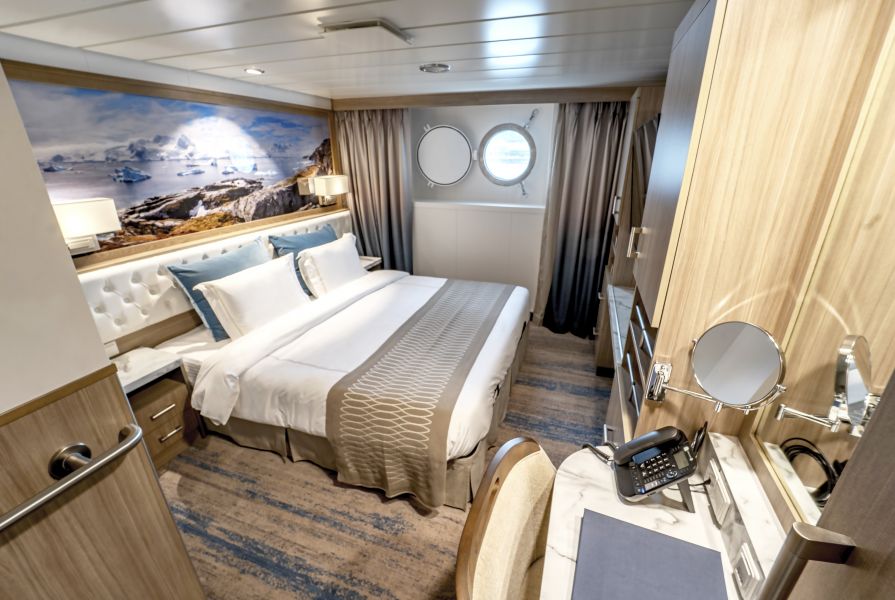
Greg Mortimer features 15 porthole rooms, all with private en-suites. Located on Deck 3, they're close to the mudroom and loading platforms, perfect for adventurers who are looking for a comfortable base that's close to the action.
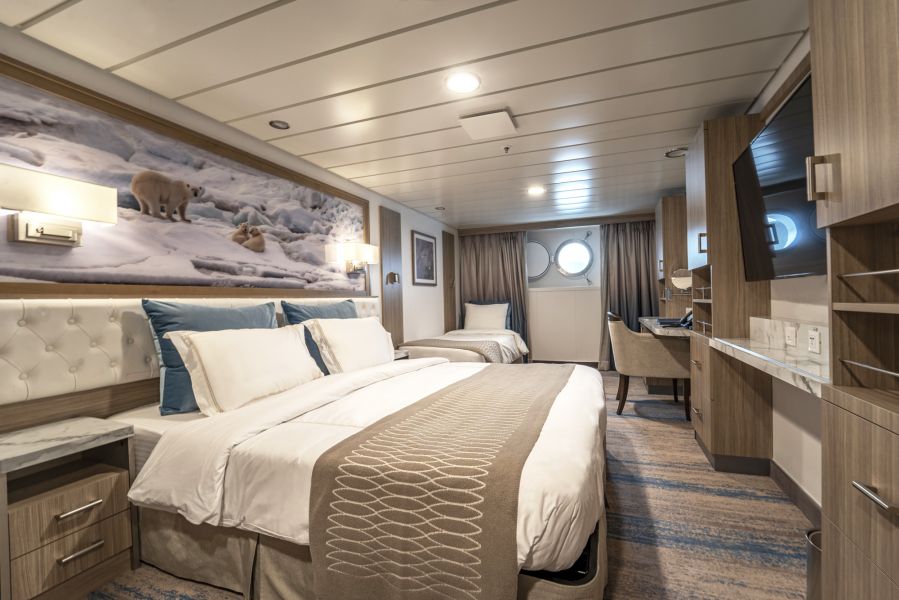
There are six Aurora Stateroom Triple cabins featuring portholes, all with private en-suites. Located on Deck 3, they're close to the mudroom and loading platforms. *Please note the Aurora Stateroom Triple cabins are only available on certain departures
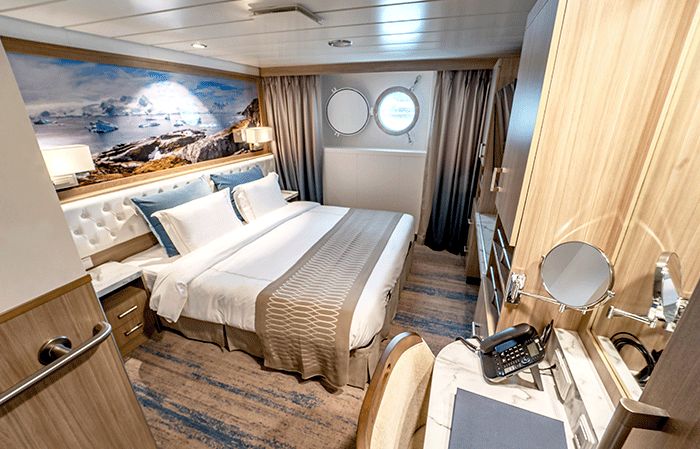
The Greg Mortimer features eight Aurora Stateroom Twin cabins featuring portholes, all with private en-suites. Located on Deck 3, they're close to the mudroom and loading platforms, perfect for adventurers who are looking for a comfortable base that's close to the action.

With 58 rooms available, the Greg Mortimer's Balcony Staterooms are the most abundant cabin category on board. All include en-suite bathrooms, floor to ceiling windows and balconies and a select number are also connecting rooms, perfect for families or groups.
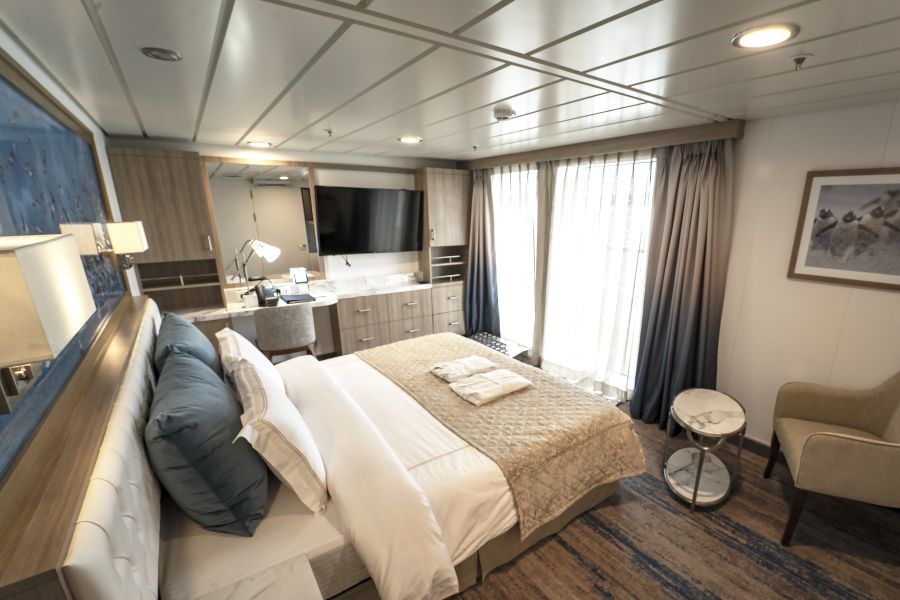
With a bit more room to stretch the legs, the Greg Mortimer's two Balcony Suites are perfect for polar adventurers who travel with plenty of gear. Featuring private balconies, en-suite bathrooms and a comfortable desk area, these will sell out quickly!
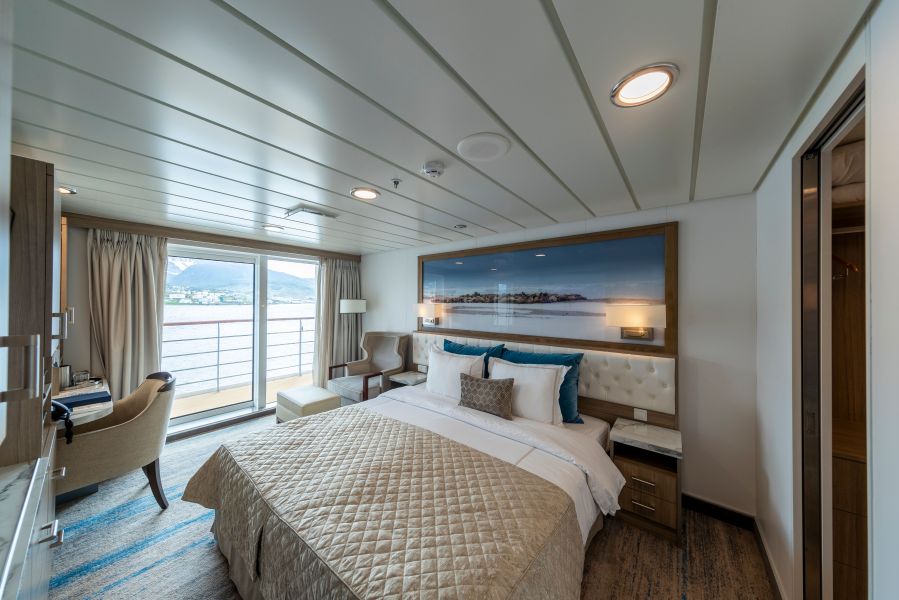
The largest of all our rooms, the Greg Mortimer's singular Captain's Suite will take you to the polar regions in ultimate style and comfort. Complete with large lounge area, balcony, walk-in wardrobe and en-suite, you'll need to get in early to secure this suite.
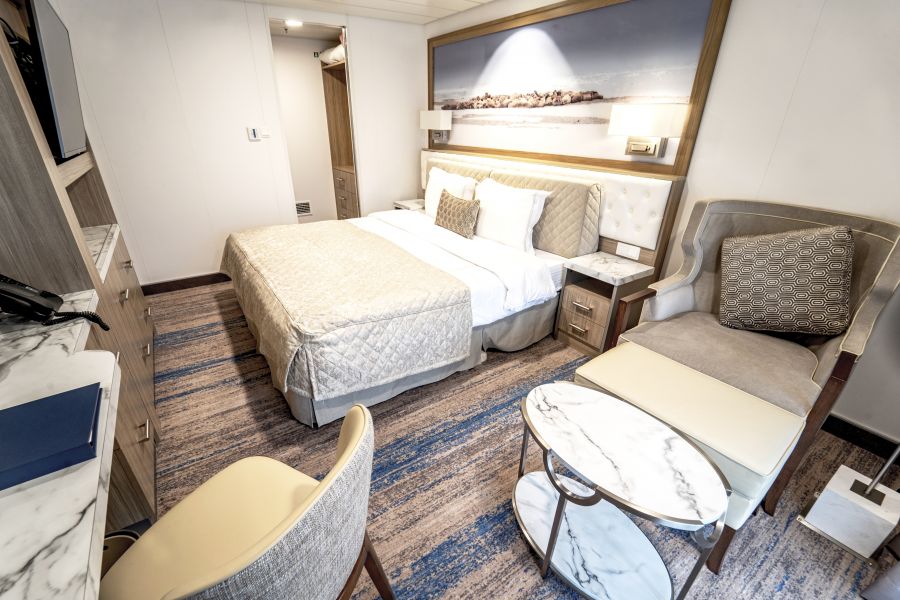
The Greg Mortimer's four Junior Suites take in some impressive∘ scenery from their vantage points on Deck 7. When you aren't enjoying a landing, you can relax in the suites' separate lounge area, or just watch the world float by from the private balcony.
The images shown are for illustration purposes only and may not be an exact representation of what you find on the ship.
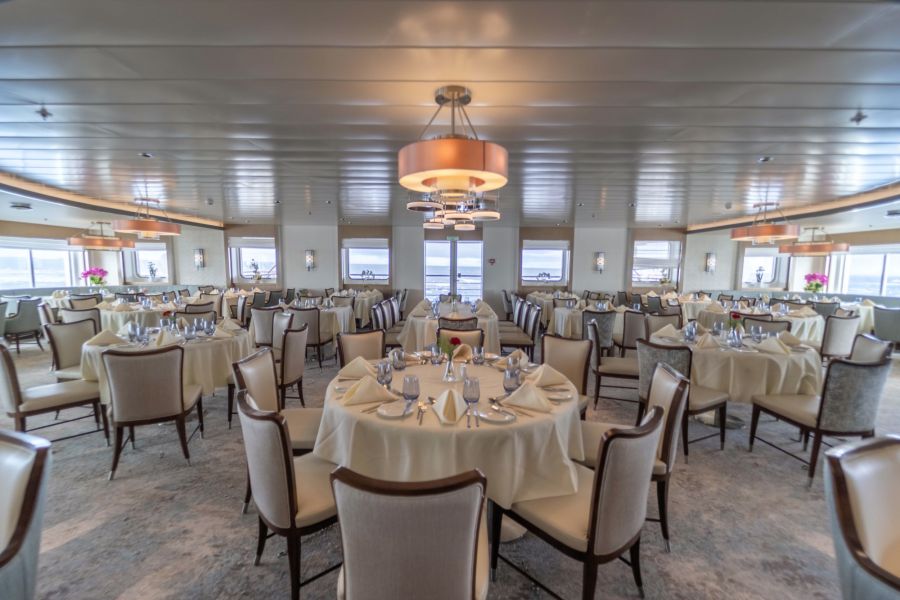
Meals are served in a large restaurant with family style dining, perfect to swap stories with your new expedition family. Additionally, a private dining area will also be available on request. Enjoy the range of house wine, beers and soft drinks included with dinner after a long day in the wild, preparing yourself for another exciting day to follow.
On the last day of your trip, the team on the Greg Mortimer put on a special farewell four-course dinner and cocktails – a perfect way to reflect on your time on the ship and consolidate lifelong friendships with the people you've met on-board.
The images shown are for illustration purposes only and may not be an exact representation of what you find on the ship.
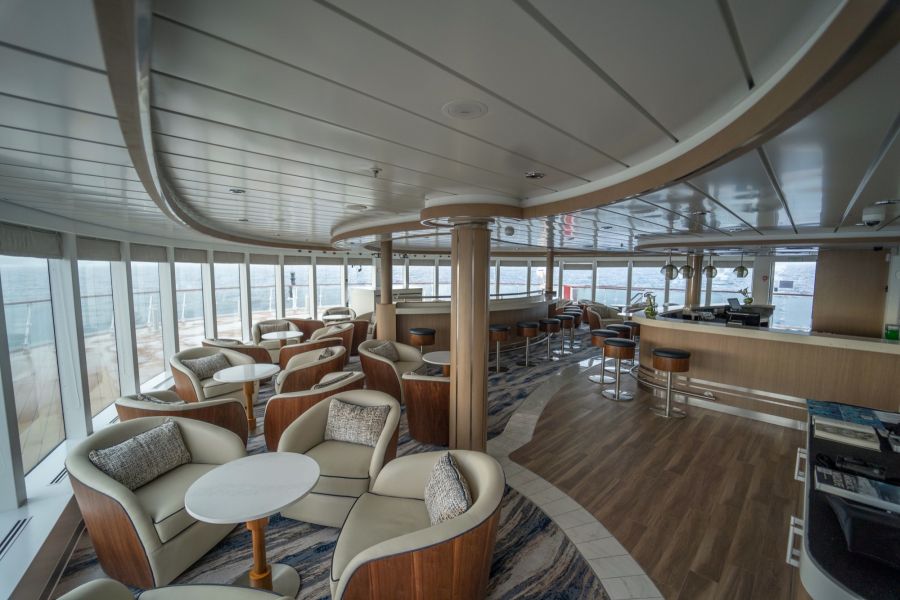
Let's face it – you don't want windowless rooms when travelling around some of the most beautiful locations around the world. This is why the Greg Mortimer is designed with plenty of dedicated observation spaces – ideal for keen bird spotters, wildlife watchers and those wanting to watch the scenery go past.
From the indoor 180-degree lounge and outdoor 360-degree open deck, both on deck 8, to the 270-degree open sundeck on level 7, there are plenty of observation points to share around the ship! If these are full, then you can take up a spot on one of the two hydraulic viewing platforms on deck 5.
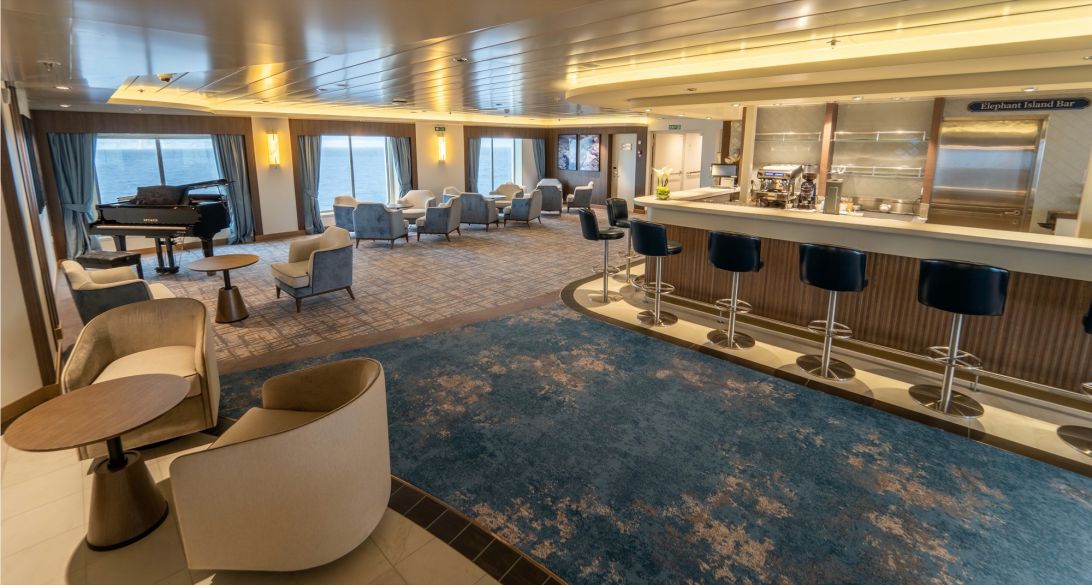
Communal meeting areas have always played a major role in fostering the warm camaraderie on board our ships. They are the heart of the expedition, where people meet to share tales from the day, swap photos, keep an eye out for wildlife and watch the sun go down.
The bars and lounges on board are refined yet inviting places to gather, with floor-to-ceiling windows offering stunning views, and of course friendly bartenders to shoot the breeze with.
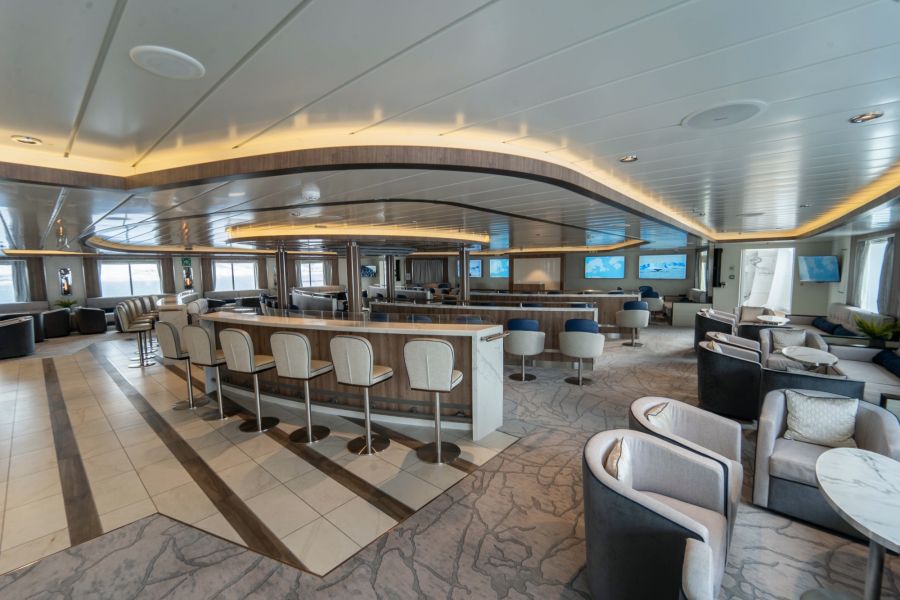
On all our expeditions, there are experts who lead presentations in the spacious lecture room so you can understand the region a little better. These often include topics as broad as history and culture to biology and climate change, these presentations aim to educate and entertain.

Whilst at sea take advantage of our onboard library where you'll find books on pioneering explorers, Aurora's destinations and the wildlife you will encounter on your voyage.

Keen photographers and artists will revel in the multimedia room on Deck 5.
The images shown are for illustration purposes only and may not be an exact representation of what you find on the ship.
The images shown are for illustration purposes only and may not be an exact representation of what you find on the ship.
| 12 nights aboard the Greg Mortimer | |||
| Fully-serviced accommodation in your chosen stateroom | |||
| An informative and entertaining lecture program by our team of experts | |||
| Complimentary 3-in-1 polar jacket and the use of gumboots | |||
| Entry fees to historic or tourist sites | |||
| Daily shore excursions, guided walks, Zodiac cruises and some activities | |||
| Daily breakfast, lunch and dinner including house wines, beers and soft drinks and afternoon tea and snacks | |||
| Complimentary use of fitness centre | |||
| Comprehensive pre-departure information kit and destination resource guide | |||
| Captain’s Welcome and Farewell Cocktail Reception including four-course dinner, house cocktails, house beer and wine, non-alcoholic beverages | |||
| Complimentary access to onboard medical doctor or clinic, if required | |||
| An experienced team of destination specialists and activity leaders | |||
| Pre-dinner cocktail hour including cold canapes and bar snacks | |||
| Photographic voyage log (post-voyage) | |||
| Port Taxes and Fees | |||
 | ABTA and ATOL Protection* | ||
Date 4th May 2023 |
Nts 13 |
Oceanview £7,516pp |
Balcony £8,156pp |
Suite £12,636pp |
Date 4th May 2023 |
Nts 13 |
Oceanview £7,516pp |
Balcony £8,156pp |
Suite £12,636pp |
| Oceanview staterooms from | £7,516pp | ||
| AS2G | Aurora Stateroom Twin | £7,516pp | |
| Balcony staterooms from | £8,156pp | ||
| BSCG | Balcony Stateroom C (Forward / Aft) | £8,156pp | |
| BSBG | Balcony Stateroom B (Off Midship) | £8,556pp | |
| BSAG | Balcony Stateroom A (Midship) | £9,196pp | |
| SBSG | Superior Balcony Stateroom | £10,076pp | |
| Suite staterooms from | £12,636pp | ||
| JSG | Junior Suite | £12,636pp | |
| CSG | Captain's Suite | £14,956pp | |
Fusion Cruises when selling travel arrangements is a trading name of The Midcounties Co-operative Ltd. Fusion Cruises is an Accredited Body Member of Midcounties Co-operative Travel Consortium. (ABTA:P6652, ATOL:6053).
Book with Confidence. We are a Member of ABTA which means you have the benefit of ABTA’s assistance and Code of Conduct.
Some of the flights and flight-inclusive holidays on this website are financially protected by the ATOL scheme but ATOL protection does not apply to all holiday and travel services offered on this website. This website will provide you with information on the protection that applies in the case of each holiday and travel service offered before you make your booking. If you do not receive an ATOL Certificate then the booking will not be ATOL protected. If you do receive an ATOL Certificate but all parts of your trip are not listed on it, those parts will not be ATOL protected. Please see our booking conditions for information, or for more information about financial protection and the ATOL Certificate go to: www.caa.co.uk
